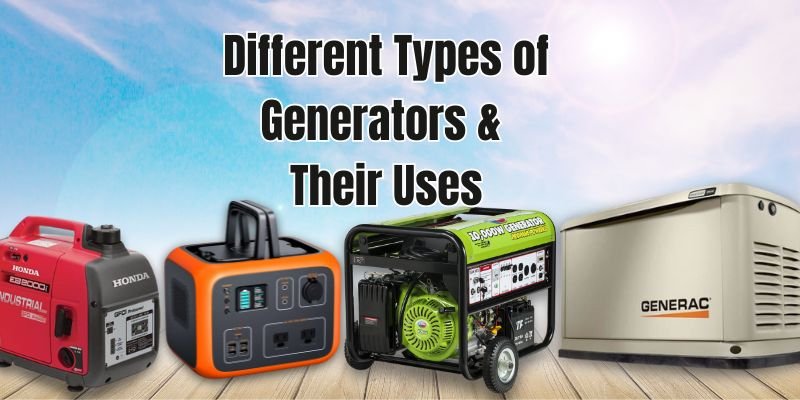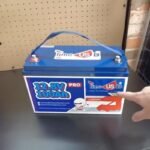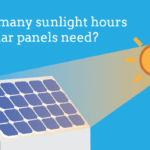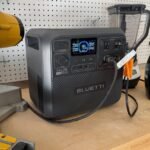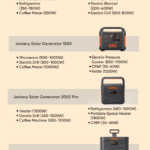Disclosure: This post contains affiliate links and I will be compensated if you make a purchase after clicking through my links. Learn More
Camping connects us with nature, but we often need power for lights, phone chargers, or a small fridge. Choosing the right generator size ensures we have enough power without hauling a heavy, noisy machine that disrupts our campsite’s peace.
For most campers, a 2000- to 3000-watt generator powers essentials like LED lights, device chargers, and small appliances efficiently.
We’ll walk you through a clear process to calculate your power needs, compare generator types, and pick the best fit for your camping style. Packed with lessons from our trips, this guide helps you select the perfect generator for a hassle-free adventure.
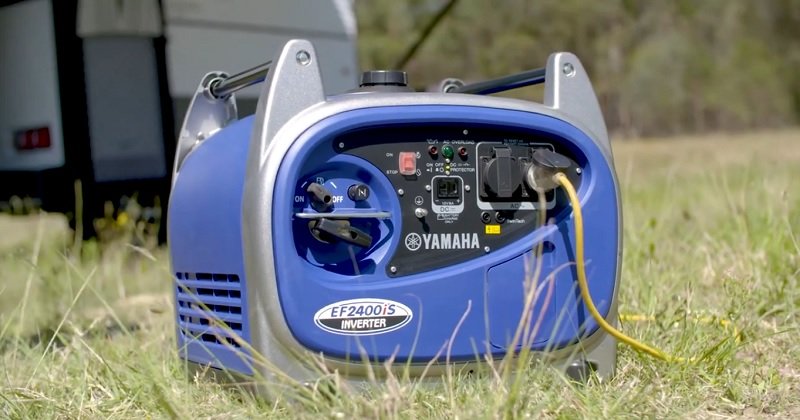
Why Choosing the Right Generator Size Matters
Picking the right generator size transforms our camping experience. A generator too small fails to run critical devices, like a fridge for food storage. A generator too large is heavy, loud, and burns extra fuel, making it tough to carry and disruptive to nature’s calm.
On a group camping trip, we brought a 1000-watt generator, expecting it to handle a small fridge and phone chargers. It overloaded and shut off mid-trip, forcing us to choose between fresh food and charged phones.
By matching the generator’s wattage to our needs, we save space, reduce noise, and enjoy a smooth trip. We’ll guide you through avoiding these pitfalls with practical steps tailored to your camping needs.
Common Mistakes to Avoid
- Underestimating Wattage: Guessing power needs leads to an underpowered generator. We’ll show you how to calculate accurately.
- Ignoring Noise: Loud generators disturb the campsite. We’ll highlight quiet options for peaceful trips.
- Overlooking Portability: Heavy generators are hard to move. We’ll focus on models that balance power and ease of transport.
How to Assess Your Camping Power Needs
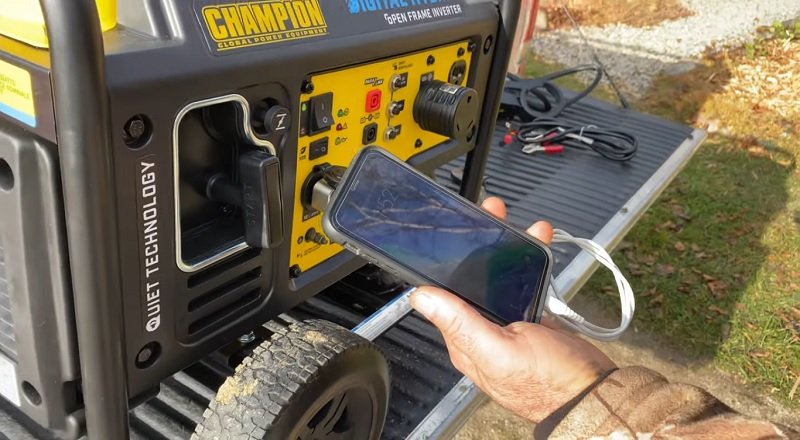
To find the right generator, we need to know exactly how much power our devices use. We’ll walk you through a simple process to list your gear, calculate wattage, and plan for simultaneous use, ensuring you pick a generator that meets your needs without guesswork.
Step 1: List Your Essential Devices
Start by writing down every device you’ll use at the campsite. Common camping gear includes:
- LED lights for tents or pathways
- Phone or tablet chargers
- Portable fans for warm nights
- Small refrigerators to keep food and drinks cold
- Laptops or tablets for movies or work
- Electric grills or coffee makers for luxury camping
- Portable heaters for chilly evenings
- CPAP machines for medical needs
On a mountain trip, we brought a small fridge, LED lights, phone chargers, and a fan. Listing everything revealed we needed more power than a basic charger could provide.
Step 2: Calculate Total Wattage
Every device uses power, measured in watts, with two types to consider:
- Running Watts: Power needed to keep the device running continuously.
- Starting Watts: Extra power some devices need to start, like fridges or fans (also called surge watts).
Check the device’s label or manual for wattage. Here’s a comprehensive table of common camping devices to help you plan:
| Device | Running Watts | Starting Watts |
|---|---|---|
| LED Light | 5-10W | 0W |
| Phone Charger | 5-20W | 0W |
| Tablet Charger | 10-30W | 0W |
| Portable Fan | 20-50W | 50-100W |
| Small Fridge | 50-150W | 100-600W |
| Laptop | 50-100W | 0W |
| Electric Grill | 600-1000W | 0W |
| Coffee Maker | 600-1200W | 0W |
| Portable Heater | 1000-1500W | 1500-2000W |
| Air Conditioner (RV) | 1000-3500W | 2000-6000W |
| Microwave | 1000-1500W | 0W |
| CPAP Machine | 30-60W | 100-200W |
To calculate total wattage, add the running watts of all devices you’ll use at once. Then, add the highest starting watts from any device. For example:
- LED Light: 10W
- Phone Charger: 20W
- Portable Fan: 50W (100W starting)
- Small Fridge: 100W (400W starting)
Total running watts = 10 + 20 + 50 + 100 = 180W. The highest starting watts is 400W (fridge). Total needed = 180W + 400W = 580W. We’d choose a generator with 700-800W to include a 10-20% buffer for safety, preventing overloads. This buffer saved us from tripped generators on multiple trips.
Step 3: Plan Simultaneous Use
Think about which devices you’ll run together. On a family trip, we ran a fridge and fan constantly but used the coffee maker only in the morning. This let us pick a smaller generator than if everything ran at once. Prioritize high-wattage devices and stagger usage to manage power efficiently. We’ll help you create a usage plan to optimize your generator choice.
Expert Tip
Always verify wattage in device manuals. We once underestimated a fridge at 50W, but it needed 150W running and 600W starting. It tripped our generator, spoiling food. Now, we check numbers and add a buffer to avoid surprises, ensuring reliable power for every trip.

Types of Camping Generators
Different generators suit different camping styles. We’ll compare three main types, portable generators, inverter generators, and portable power stations, with detailed features to help you find the perfect match for your needs.
Portable Generators
Portable generators deliver high power and durability, ideal for running multiple devices like a fridge and electric grill.
- Power Output: 1000-7000W, great for heavy appliances.
- Fuel Type: Gasoline, propane, or dual-fuel for flexibility.
- Weight: 50-150 lbs, sturdy but heavier.
- Noise Level: 65-75 dB, like a loud conversation.
- Run Time: 6-12 hours per tank, depending on load.
- Best For: RV camping, long trips, high power needs.
On a group RV trip, we used a 4000W portable generator to power a coffee maker, fridge, and lights. It handled everything but was noisy, so we placed it 20 feet from our site to reduce disturbance. Check fuel consumption, as these use more gas than other types.
Inverter Generators
Inverter generators are quieter and more efficient, perfect for smaller setups or noise-sensitive campgrounds.
- Power Output: 1000-4000W, good for lights, chargers, small fridges, and CPAP machines.
- Noise Level: 50-60 dB, like normal talking.
- Clean Power: Low THD (< 5%), safe for sensitive electronics like phones and laptops.
- Weight: 20-60 lbs, easy to carry with handles.
- Run Time: 8-10 hours in eco-mode.
- Best For: Tent camping, small RVs, quiet sites.
We love inverter generators for tent camping. On a lakeside trip, our 2000W inverter generator powered a fan, chargers, and a CPAP machine without waking neighbors. They’re pricier but worth it for quiet, reliable power.
Portable Power Stations
Portable power stations, often called solar generators, use batteries and don’t need fuel. They’re silent and eco-friendly, ideal for light camping or green campers.
- Power Output: 200-2000W, great for lights, chargers, small fridges, and CPAP machines.
- Noise Level: 0 dB, completely silent.
- Weight: 10-40 lbs, highly portable with handles.
- Charging Options: Solar panels (100-200W), wall outlets, or car chargers.
- Battery Capacity: 200-2000Wh, enough for 1-2 days of light use.
- Best For: Minimal setups, eco-conscious camping, noise-restricted sites.
- Downside: Limited battery life, requires recharging.
On a hiking trip, we carried a 500W portable power station in a backpack to charge phones and power LED lights. It was silent and light, keeping our site calm. Models like the EcoFlow RIVER 2 (600W, 256Wh) or Jackery Explorer 500 (500W, 518Wh) shine for small setups. For top picks, check our guide to the best portable power stations for camping.
Choosing the Right Type
We’ll help you weigh these options based on your camping style. For RV camping with air conditioners, portable generators offer the power you need. For tent camping in quiet sites, inverter generators or portable power stations keep noise down and electronics safe. Our trips show a 2000W inverter or 500-1000W power station suits most campers.
Key Features to Look for in a Camping Generator
Size is only part of the equation. We’ll guide you through essential features to ensure your generator is practical, safe, and efficient for camping, with insights from our real-world use.
Fuel Efficiency
A fuel-efficient generator runs longer on less fuel, saving money and refills.
- Eco-Mode: Adjusts engine speed to match power demand, extending runtime to 8-12 hours.
- Fuel Types: Gasoline, propane, or dual-fuel for flexibility.
- Tank Size: 1-4 gallons for portable/inverter models, larger for heavy use.
On a desert trip, our generator ran out of gas mid-cooking because we skipped eco-mode. Now, we choose models like the Honda EU2200i with eco-mode for longer runtime.
Noise Level
A quiet generator keeps our campsite peaceful and meets campground rules (often 60 dB max at 50 feet).
- Portable Generators: 65-75 dB, like a loud talk.
- Inverter Generators: 50-60 dB, like normal conversation.
- Portable Power Stations: 0 dB, silent.
- Features: Mufflers or insulated casings reduce noise.
We got complaints once with a 70 dB portable generator, so we switched to a 52 dB inverter model. Portable power stations are best for noise-free camping.
Portability
Camping means moving gear, so our generator should be easy to carry.
- Weight: 20-60 lbs for small or inverter models, 50-150 lbs for portable ones.
- Features: Handles, wheels, or compact designs for transport.
- Storage: Fits in car trunks (e.g., 24″x18″x18″ for small models) or RV compartments.
A 30-lb portable power station was perfect for a backpacking trip, fitting in our car trunk. We check dimensions to ensure easy storage.
Safety Features
Safety is critical in remote areas.
- Low-Oil Shutoff: Stops the generator to protect the engine.
- Circuit Breakers: Prevents overloads.
- CO Detection: Shuts off fuel-based generators if carbon monoxide rises.
- Grounding: Ensures safe use in wet conditions.
We place fuel-based generators 10-20 feet from tents to avoid carbon monoxide, a habit formed after a stuffy night. CO detection, like in Champion models, adds safety.
Clean Power
Sensitive devices like phones, laptops, and CPAP machines need clean power (THD < 5%) to avoid damage.
- Inverter Generators: Provide clean power for electronics.
- Portable Power Stations: Also deliver clean power, ideal for minimal setups.
We fried a charger once with a high-THD generator, so we use inverter generators or portable power stations like the EcoFlow Delta 2 for safe charging.
Output Ports
Multiple ports let us power various devices.
- AC Outlets: For appliances like fridges (120V, 15-30A).
- USB Ports: For phones and tablets (USB-A, USB-C, 5-20W).
- DC Ports: For car chargers or 12V devices (8-10A).
Our EcoFlow Delta 2’s 15 ports (6 AC, 4 USB-A, 2 USB-C, 3 DC) handled all our devices on a family trip, making it versatile for camping.
Battery Life (Portable Power Stations)
For portable power stations, battery capacity (measured in watt-hours, Wh) determines runtime.
- Capacity: 200-2000Wh, enough for 1-2 days of light use.
- Recharge Time: 1-6 hours via wall, 4-10 hours via solar (100W panel).
- Cycles: 500-3000 charge cycles before capacity drops.
We recharged a 500Wh power station with a 100W solar panel in 6 hours, keeping our devices powered all weekend.
Popular Generator Sizes for Different Camping Scenarios
Generator size depends on our camping style. We’ll break down each size with real-world examples to help you choose the right one.
Small Generators (1000-2000W)
Small generators suit tent camping or minimal setups.
- Devices: LED lights (5-10W), phone chargers (5-20W), small fans (20-50W), CPAP machines (30-60W).
- Benefits: Lightweight (20-40 lbs), quiet (50-60 dB), fuel-efficient.
- Example: Our 1000W Yamaha EF2000iSv2 powered lights and chargers on a solo trip flawlessly.
Medium Generators (2000-4000W)
Medium generators work for family camping or small RVs.
- Devices: Small fridge (50-150W), coffee maker (600-1200W), portable heater (1000-1500W).
- Benefits: Balances power and portability, moderate noise (55-65 dB).
- Example: A 3000W Honda EU3000iS ran our family’s fridge and fan without issues.
Large Generators (4000-7000W)
Large generators are for RV camping with high power needs.
- Devices: Air conditioner (1000-3500W), large fridge (150-300W), microwave (1000-1500W).
- Benefits: Powers multiple appliances, reliable for long stays.
- Downsides: Heavy (100-200 lbs), noisy (65-75 dB).
- Example: Our 6000W Champion powered an RV’s AC and appliances smoothly.
| Generator Size | Wattage Range | Ideal For |
|---|---|---|
| Small | 1000-2000W | Tent camping, lights, chargers |
| Medium | 2000-4000W | Family camping, small RVs, fridges |
| Large | 4000-7000W | RV camping, AC, large appliances |
Pros and Cons of Generator Sizes
Each size has trade-offs. We’ll compare them to help you decide which fits your camping needs.
Small Generators (1000-2000W)
- Pros: Easy to carry, saves fuel, quiet, affordable ($400-800).
- Cons: Limited to small devices, can’t run air conditioners or microwaves.
- Best Model: Yamaha EF2000iSv2 (2000W, 44.1 lbs).
Medium Generators (2000-4000W)
- Pros: Runs multiple devices, portable, versatile for families or small RVs.
- Cons: Heavier (50-100 lbs), moderate fuel use.
- Best Model: Honda EU3000iS (3000W, 131 lbs).
Large Generators (4000-7000W)
- Pros: Powers big appliances, ideal for RV camping.
- Cons: Heavy, loud, expensive ($1000+), high fuel use.
- Best Model: Champion 100263 (3400W, 95.7 lbs, dual-fuel).
We find a 2000-3000W inverter generator or portable power station best for most trips, offering power and portability without excessive noise.
Tips for Using Your Camping Generator Efficiently
To make our generator work well and stay safe, we’ll share practical tips from our camping experiences to maximize performance and reliability.
Maintenance Tips
- Check Oil: Every 8 hours, check levels and use the recommended oil (e.g., SAE 10W-30).
- Clean Air Filter: Every 50 hours, clean or replace for efficiency.
- Inspect Spark Plugs: Every 100 hours, check for wear and replace.
- Store Properly: Keep in a dry, covered place to prevent rust.
We skipped an air filter cleaning once, and our generator sputtered mid-trip. Regular maintenance keeps it reliable.
Safe Operation
- Use Outdoors: Place fuel-based generators 10-20 feet from tents to avoid carbon monoxide poisoning.
- Cool Before Refueling: Let it cool for 15 minutes to prevent fires.
- Use Heavy-Duty Cords: Outdoor-rated cords (12-14 gauge, 15-30A) prevent overheating.
- Avoid Overloading: Stay within wattage limits using a power strip with a breaker.
We use a CO detector near our tent for extra safety with fuel-based models.
Power Management
- Prioritize Devices: Run high-wattage devices (e.g., fridge) first, then add smaller ones.
- Use Solar Charging: Pair portable power stations with 100-200W solar panels for daytime power.
- Monitor Usage: Use a wattage meter ($20-30) to track real-time power draw.
On a sunny trip, we recharged our EcoFlow RIVER 2 with a 100W solar panel in 6 hours, keeping devices powered all weekend.
Weather Protection
- Cover in Rain: Use a generator tent or tarp (ventilated) to protect from water.
- Avoid Extreme Heat: Keep out of direct sun to prevent overheating.
- Stable Surface: Place on flat ground to avoid tipping.
We learned to cover our generator after a rainstorm caused a short, a tip we now swear by.
Top Generator Brands for Camping
Quality matters, so we’ll highlight three top brands with models tailored for camping, including specific recommendations to suit your needs.
Honda
- Features: Quiet (50-60 dB), fuel-efficient (8-10 hours), reliable.
- Models:
- Honda EU2200i: 2200W, 46.5 lbs, 8-hour runtime, 2 AC outlets, great for small setups.
- Honda EU3000iS: 3000W, 131 lbs, 10-hour runtime, ideal for medium needs.
- Why We Like It: Our EU2200i powered lights and chargers on a quiet trip without issues.
Yamaha
- Features: Durable, clean power (THD < 5%), easy maintenance.
- Models:
- Yamaha EF2000iSv2: 2000W, 44.1 lbs, 8.5-hour runtime, perfect for tent camping.
- Yamaha EF3000iSEB: 3000W, 154.3 lbs, suits small RVs.
- Why We Like It: The EF2000iSv2 kept our campsite powered quietly, earning campsite praise.
Champion
- Features: Affordable, dual-fuel options, strong power.
- Models:
- Champion 100692: 2000W, 39.5 lbs, budget-friendly for small setups.
- Champion 100263: 3400W, 95.7 lbs, versatile for families, dual-fuel.
- Why We Like It: A dual-fuel Champion saved us when gas was scarce, switching to propane easily.
Portable Power Station Picks
- EcoFlow RIVER 2: 600W, 256Wh, 7.7 lbs, 6 ports (2 AC, 2 USB-A, 1 USB-C, 1 DC), solar charging (110W max).
- Jackery Explorer 500: 500W, 518Wh, 13.3 lbs, 7 ports (3 AC, 2 USB-A, 1 USB-C, 1 DC), compact design.
- EcoFlow Delta 2: 1800W, 1024Wh, 27 lbs, 15 ports (6 AC, 4 USB-A, 2 USB-C, 3 DC), fast charging (80 min via wall).
The EcoFlow Delta 2’s 15 ports powered all our devices on a family trip, making it a versatile choice.
Advanced Considerations for Power Planning
For a deeper approach, we’ll explore factors to fine-tune your generator choice, ensuring it performs in diverse camping scenarios.
- Parallel Capability: Some inverter generators (e.g., Honda EU2200i) can pair with another unit to double power, great for occasional high needs.
- Altitude Adjustment: At high altitudes (>5000 ft), fuel-based generators lose 3-4% power per 1000 ft. We adjusted our carburetor at a mountain campsite to maintain performance.
- Battery Expansion: Some portable power stations (e.g., EcoFlow Delta 2) allow extra batteries for extended capacity, ideal for long trips.
- Solar Panel Size: Match solar panels to power station input (e.g., 100-200W for 500Wh units). We used a 200W panel for faster charging in sunny conditions.
These details, drawn from our high-altitude and off-grid trips, ensure your generator meets your specific needs.
Frequently Asked Questions
1. How many watts does a camping generator need?
A camping generator needs 2000-3000 watts for most setups, powering lights, chargers, and small fridges. RV camping may need 3000-4000 watts for air conditioners. Calculate your devices’ wattage for accuracy.
2. Can a 2000-watt generator run a camper?
A 2000-watt generator runs basic camper appliances like lights, fans, and chargers. It may not handle air conditioners or microwaves. Check appliance wattage to confirm it meets your needs.
3. Are inverter generators good for camping?
Inverter generators are excellent for camping. They’re quiet (50-60 dB), fuel-efficient, and provide clean power for phones and laptops. Their light weight suits tent camping well.
4. What size generator is best for RV camping?
A 3000-4000-watt generator is best for RV camping, running air conditioners, fridges, and microwaves. Larger RVs with multiple appliances may need 4000-7000 watts for reliable power.
5. Are portable power stations good for camping?
Portable power stations are great for camping. They’re silent, eco-friendly, and light, ideal for charging phones and running lights. Models like the EcoFlow RIVER 2 suit minimal setups.
Final Thoughts
Choosing the right generator size makes our camping trips comfortable and fun. A 2000-3000-watt generator powers most essentials, like lights, chargers, and small fridges, while larger RVs may need 4000-7000 watts. By listing devices, calculating wattage with a buffer, and picking a quiet, portable model, we keep our campsite powered and peaceful. Whether we choose a portable generator, inverter generator, or portable power station like the EcoFlow Delta 2, matching the size to our needs ensures a great adventure. Happy camping!

